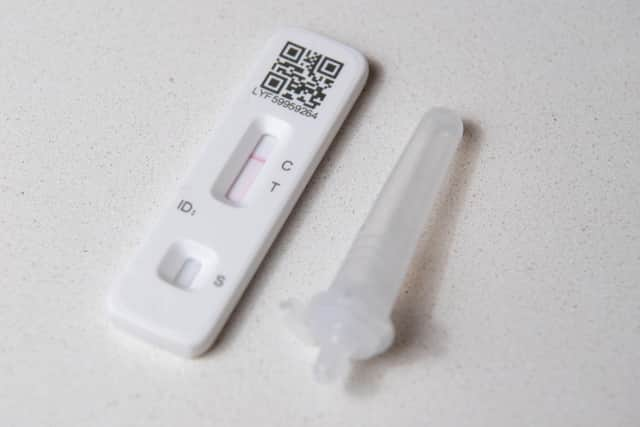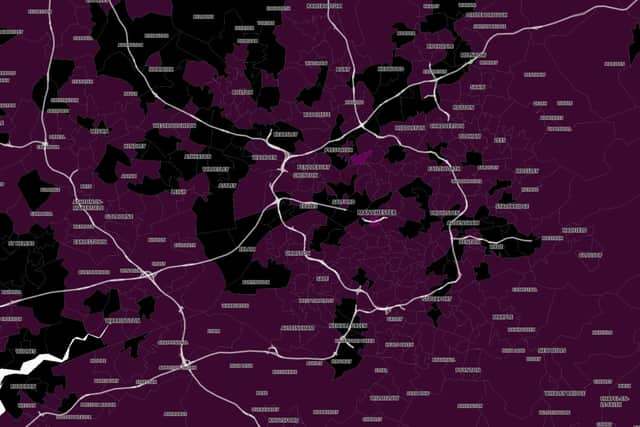Has Omicron peaked in Greater Manchester? New figures show drop in Covid rates
and live on Freeview channel 276
A total of 35,158 people tested positive for coronavirus across Greater Manchester in the week which ended on 12 January, new figures show.
Cases are continuing to decline in the region, although infection rates still remain higher than the national average standing at 1,239.8 cases per 100,000 people.
Advertisement
Hide AdAdvertisement
Hide AdHowever, this is a significant drop from a rate of 2,232.6 last week.
Secretary of State for Education Nadhim Zahawi has said that with continued falling cases, some Plan B rules in England could soon be lifted when measures are reviewed by the government on January 26.
According to the latest local data, the top 10 local infection hotspots for the virus are spread across Bolton, Salford, Rochdale, Wigan, Manchester and Tameside.
However each area is seeing much lower infection rates than in the first weeks after the Christmas period where they exceeded more than 3,000 per 100,000 residents.


Advertisement
Hide AdAdvertisement
Hide AdCoronavirus ‘hotspots’ and ‘notspots’ can be revealed via an interactive map charting the number of positive Covid-19 test results in each neighbourhood across the country using government data.
It shows the number of infections per local area, broken down into neighbourhoods containing roughly 7,000 people.
The number of new cases is then used to calculate the infection rate per 100,000 people.
Where have infection rates been growing?
In the week to January 11 the latest hyperlocal data shows the biggest hotspot was Over Hulton in Bolton.
Advertisement
Hide AdAdvertisement
Hide AdIt recorded an infection rate of 2,270.9, with 138 new incidences of the virus, a drop of 13 cases.
In second place is Horwich South & Middlebrook, also in Bolton, where there were 174 cases and the rate was 2,199.7.
There cases had dropped by 63 from the last seven day period.


The Rochdale neighbourhood of Littleborough West and Wardle follows with a rate of 2,105.6, and 136 cases of Covid-19 being recorded.
Advertisement
Hide AdAdvertisement
Hide AdHeywood Town, also in Rochdale, is in fourth place with 222 new cases and a local infection rate of 2,101.5 per 100,000 people.
The neighbourhood saw cases drop by 117 from the previous week.
Next is Peel Green in Salford, where the 128 weekly cases led to a rate of 2,089.5.
Leigh Central in Wigan is in sixth place.
It recorded 140 new cases of Covid-19, totalling an infection rate of 2,074.1.
Advertisement
Hide AdAdvertisement
Hide AdNewall Green, in Manchester, had a rate of 2,016.8 in the week to January 11, with 168 people testing positive for coronavirus.
In eighth place is the Tameside neighbourhood of Newtonmoor, where 146 cases of the virus were recorded.
This works out as a local infection rate of 2,004.1 per 100,000 people.
Daubhill and Fernhill Gate in Bolton is next with 148 cases, equalling a rate of 1,993.8.
Advertisement
Hide AdAdvertisement
Hide AdFinally Horwich East, also in the borough of Bolton, is in tenth place with 119 cases and a local infection rate of 1,942.5.
Where has the lowest infection rates in Greater Manchester?
At the other end of the scale, the Manchester locality of University North and Whitworth Street has the lowest infection rate in the region, standing at just 675.9 with 75 new cases.
It is followed by Sedgley Park in Bury with 74 cases and a rate of 764.1.
In third place is the Salford neighbourhood of Broughton Park, where 59 people tested positive in the week to January 11.
This equals a rate of 802.6 per 100,000 people.
Advertisement
Hide AdAdvertisement
Hide AdWoodbank Park in Stockport is next with 48 new cases and a rate of 835.4.
In fifth place is the Manchester area of Fallowfield Central.
The 106 cases recorded there convert to an infection rate of 894.3.
Whitefield West and Park Lane in Bury follows with a rate of 923.1 and 64 new cases of Covid-19.
This was a drop of 128 cases from the previous week.
Advertisement
Hide AdAdvertisement
Hide AdDiggle, Delph and Denshaw in Oldham is in seventh place with a local rate of 935.8, and 51 cases recorded in the week to January 11.
Rusholme East in Manchester also makes it into the top ten areas with the lowest infection rates with a rate of 948.3 and 129 new cases.
Piccadilly and Ancoats, also in Manchester is in ninth place with 192 incidences of the virus, resulting in an infection rate of 973.9.
Finally Higher Woodhill in Bury is in tenth place with a rate of 980.4 from 56 new cases.
Comment Guidelines
National World encourages reader discussion on our stories. User feedback, insights and back-and-forth exchanges add a rich layer of context to reporting. Please review our Community Guidelines before commenting.